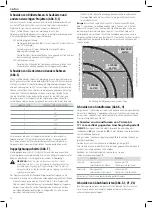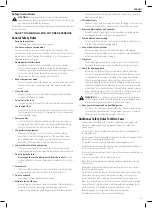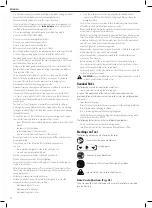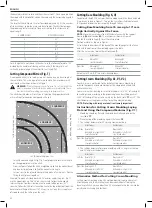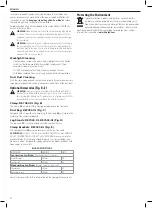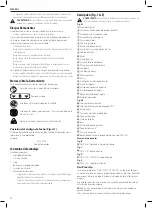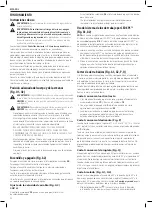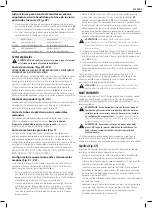
38
EnGLISh
adjustment knobs. Make a dry cut first to ensure the blade does not contact
the fences.
nOTE:
The tracks of the fences can become clogged with sawdust. Use a
brush or some low pressure air to clear the guide grooves.
Guard Actuation and Visibility (Fig. A1)
The lower guard
1
on your saw has been designed to automatically
uncover the blade when the arm is brought down and to cover the blade
when the arm is raised.
The guard can be raised by hand when installing or removing saw blades
or for inspection of the saw. NEVER RAISE THE lower GUARD MANUALLY
UN LESS THE BLADE IS STOPPED.
Kerf Plate Adjustment (Fig. A1)
To adjust the kerf plates
23
, loosen the screws holding the kerf plates
in place. Adjust so that the kerf plates are as close as possible without
interfering with the blade’s movement.
If a zero kerf width is desired, adjust the kerf plates as close to each other
as possible. They can now be cut slowly with the saw blade to give the
smallest gap possible between the blade and the kerf plates.
Rail Guide Adjustment (Fig. A1)
Regularly check the rails
10
for play or clearance.
The right rail can be adjusted with the set screw
8
. To reduce clearance,
use a 4 mm hex wrench and rotate the set screw clockwise gradually while
sliding the saw head back and forth.
Mitre Lock Adjustment (Fig. A1, N)
The mitre lock rod
55
should be adjusted if the table of the saw can be
moved when the mitre lock handle is locked (down).
1. Put the mitre lock handle
21
in the unlocked (up) position.
2. Using a 13 mm open end wrench, loosen the lock nut
56
on the mitre
lock rod.
3. Using a slotted screwdriver, tighten the mitre lock rod by turning it
clockwise as shown in Figure N. Turn the lock rod until it is snug, then
turn counterclockwise one turn.
4. Re-lock the mitre lock to a non-detented measurement on the mitre
scale – for example, 34° – and make sure the table will not rotate.
5. Tighten lock nut.
Prior to Operation
• Install the appropriate saw blade. Do not use excessively worn blades.
The maximum rotation speed of the tool must not exceed that of the
saw blade. Do not use any abrasive blades.
• Do not attempt to cut excessively small pieces.
• Allow the blade to cut freely. Do not force.
• Allow the motor to reach full speed before cutting.
• Make sure all locking knobs and clamp handles are tight.
• Secure the workpiece.
• Although this saw will cut wood and many nonferrous materials, these
operating instructions refer to the cutting of wood only. The same
guidelines apply to the other materials. Do not cut ferrous (iron and
steel) materials, fibre cement or masonry with this saw!
• Make sure to use the kerf plate. Do not operate the machine if the kerf
slot is wider than 10 mm.
OPERATION
Instructions for Use
WARNING:
Always observe the safety instructions and
applicable regulations.
WARNING: To reduce the risk of injury, turn unit off and
disconnect machine from power source before installing and
removing accessories, before adjusting or changing set-ups
or when making repairs.
Be sure the trigger switch is in the OFF
position. An accidental start-up can cause injury.
Refer to
Saw Blades
under
Optional Accessories
to select the blade that
best fits your needs.
Ensure the machine is placed to satisfy your ergonomic conditions in terms
of table height and stability. The machine site shall be chosen so that the
operator has a good overview and enough free surrounding space around
the machine that allows handling of the workpiece without any restrictions.
To reduce effects of vibration make sure the environment temperature is
not too cold, the machine and accessories are well maintained and the
workpiece size is suitable for this machine.
The attention of UK users is drawn to the “woodworking machines regulations
1974” and any subsequent amendments.
Plug the saw into any household 60 Hz power source. Refer to the
nameplate for voltage. Be sure the cord will not interfere with your work.
Proper Body and Hand Position (Fig. O1, O2)
WARNING:
To reduce the risk of serious personal injury,
ALWAYS
use
proper hand position as shown in Figure O1.
WARNING:
To reduce the risk of serious personal injury,
ALWAYS
hold
securely in anticipation of a sudden reaction.
• Never place hands near cutting area. Place hands no closer than
100 mm from the blade.
• Hold the workpiece tightly to the table and the fence when cutting.
Keep hands in position until the trigger has been released and the blade
has completely stopped.
• ALWAYS MAKE DRY RUNS (UNPOWERED) BEFORE FINISH CUTS SO THAT
YOU CAN CHECK THE PATH OF THE BLADE. DO NOT CROSS HANDS, AS
SHOWN IN FIGURE O2.
• Keep both feet firmly on the floor and maintain proper balance. As you
move the mitre arm left and right, follow it and stand slightly to the side
of the saw blade.
• Sight through the guard louvers when following a pencil line.
Switching On and Off (Fig. A2)
To turn the saw on, depress the trigger switch
24
. To turn the tool off,
release the trigger switch.
Allow the blade to spin up to full operating speed before making the cut.
Release the trigger switch and allow the brake to stop the blade before
raising the saw head.
A hole is provided in the trigger switch for insertion of a padlock to lock the
saw off.
Setting the Variable Speed (Fig. A2)
DWS780
The speed control dial
34
can be used for advance setting of the required
range of speed.
• Turn the speed control dial
34
to the desired range, which is indicated
by a number.
• Use high speeds for sawing soft materials such as wood.
Use low speeds for sawing metal.
Use of XPS
™
LED Worklight System (Fig. A1, A2)
nOTE:
The mitre saw must be connected to a power source.
The XPS™ LED Worklight System is equipped with an on/off switch
25
.
The XPS™ LED Worklight System is independent of the mitre saw’s trigger
switch. The light does not need to be on in order to operate the saw.
To cut through an existing pencil line on a piece of wood:
1. Turn on the XPS™ system, then pull down on the operating handle
3
to bring the saw blade close to the wood. The shadow of the blade will
appear on the wood.
2. Align the pencil line with the edge of the blade’s shadow. You may
have to adjust the mitre or bevel angles in order to match the pencil
line exactly.
Summary of Contents for DWS779
Page 1: ...Final Page Size 172 x 240 mm DWS779 DWS780 ...
Page 4: ...2 Fig D Fig C Fig B Fig E Fig G1 Fig F 2 1 35 37 36 38 ...
Page 6: ...4 Fig N Fig O1 Fig O2 Fig L Fig M Fig K 73 mm 21 21 55 56 58 59 7 ...
Page 7: ...5 Fig Q Fig S Fig P Fig T Fig U 2 Fig R 1 A ...
Page 8: ...6 Fig X1 ss Fig X2 Fig W1 Fig W2 Fig V2 Fig V1 42 14 14 42 14 17 17 14 ...
Page 9: ...7 Fig Y Fig Z1 Fig Z2 15 1 15 13 57 ...
Page 162: ......
Page 163: ......





